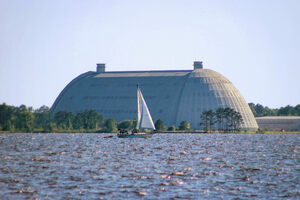Weeksville Dirigible Hangar in Elizabeth City, North Carolina

Just south of Elizabeth City, North Carolina, an impressive structure rises from the shores of the Pasquotank River. The large, silvery dome measures 20 stories tall and nearly a thousand feet wide. While it might look like a futuristic laboratory, this building is actually one of the few remaining structures that were built during World War II to manufacture, house, and service the U.S Navy’s blimps.
Yes, you read that right. Though fighter planes and aircraft-carrying ships tend to get more attention, blimps became a big part of the United States’ defense program after the attack on Pearl Harbor. Helium-lifted airships floated above American coastal waters, where they watched for signs of enemy ships.
Construction began on the Weeksville Naval Air Station in 1941 and it was formally commissioned on April 1, 1942. The station spanned 822 acres, but the crown jewel was a steel hangar with enough room for 12 K-class airships. From end to end, these blimps measured more than 250 feet long, and were capable of carrying their 18-member crews from the base to the ocean in half an hour, and could stay in the air for as long as two days without a refueling.
The patrols were an effective deterrent. In the first few months of 1942, German U-boats had torpedoed dozens of ships off the Carolina coast, but once the blimps started going up, the attacks quickly fell off. Airship crews had the advantage of perspective: From the air, they could easily spot a submarine at shallow depth. The blimps were armed with machine guns and depth charges, and could also call nearby warships for backup.
After the war ended, Weeksville remained in limited operation until 1957, when the base closed down for good. Many of the smaller buildings were torn down, but the large steel hangar and a smaller wooden one remained. In 1995, the wooden hangar burned down in an accidental fire. The old wooden building burned hot and fast—by the next morning, only the concrete pillars that once stood at the air dock’s corners remained.
Luckily, the massive steel hangar survived, and is one of the few surviving airship hangars built during WWII. Today, as a test facility for TCOM Airships, the immense steel structure has returned to its intended purpose.





